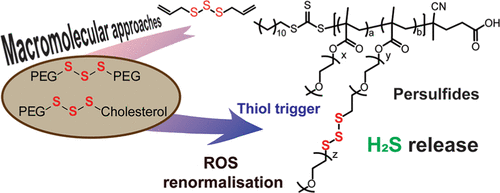当前位置:
X-MOL 学术
›
Biomacromolecules
›
论文详情
Our official English website, www.x-mol.net, welcomes your
feedback! (Note: you will need to create a separate account there.)
Trisulfide-Bearing PEG Brush Polymers Donate Hydrogen Sulfide and Ameliorate Cellular Oxidative Stress
Biomacromolecules ( IF 5.5 ) Pub Date : 2020-11-19 , DOI: 10.1021/acs.biomac.0c01347 Nam V Dao 1, 2 , Francesca Ercole 1 , Lisa M Kaminskas 3 , Thomas P Davis 1, 4 , Erica K Sloan 5, 6 , Michael R Whittaker 1 , John F Quinn 1, 7
Biomacromolecules ( IF 5.5 ) Pub Date : 2020-11-19 , DOI: 10.1021/acs.biomac.0c01347 Nam V Dao 1, 2 , Francesca Ercole 1 , Lisa M Kaminskas 3 , Thomas P Davis 1, 4 , Erica K Sloan 5, 6 , Michael R Whittaker 1 , John F Quinn 1, 7
Affiliation

|
A potential approach to combat cellular dysfunction is to manipulate cell communication and signaling pathways to restore physiological functions while protecting unaffected cells. For instance, delivering the signaling molecule H2S to certain cells has been shown to restore cell viability and re-normalize cell behavior. We have previously demonstrated the ability to incorporate a trisulfide-based H2S-donating moiety into linear polymers with good in vitro releasing profiles and demonstrated their potential for ameliorating oxidative stress. Herein, we report two novel series of brush polymers decorated with higher numbers of H2S-releasing segments. These materials contain two trisulfide-based monomers co-polymerized with oligo(ethylene glycol methyl ether methacrylate) via reversible addition–fragmentation chain-transfer polymerization. The macromolecules were characterized to have a range of trisulfide densities with similar, well-defined molecular weight distribution, good H2S-releasing profiles, and high cellular tolerance. Using an amperometric technique, the H2S liberated and total sulfide release were found to depend on concentrations and chemical nature of triggering molecules (glutathione and cysteine) and, importantly, the position of reactive groups within the brush structure. Notably, when introduced to cells at well-tolerated doses, two macromolecular donors which have the same proportion as of the H2S-donating monomer (30%) but differ in releasing moiety location show similar cellular H2S-releasing kinetics. These donors can restore reactive oxygen species levels to baseline values, when polymer pretreated cells are exposed to exogenous oxidants (H2O2). Our work opens up a new aspect in preparing H2S macromolecule donors and their application to arresting cellular oxidative cascades.
中文翻译:

含三硫化物的PEG刷聚合物可提供硫化氢并改善细胞的氧化应激
对抗细胞功能障碍的潜在方法是操纵细胞的通讯和信号通路,以恢复生理功能,同时保护未受影响的细胞。例如,已经证明将信号传导分子H 2 S递送至某些细胞可以恢复细胞活力并重新规范细胞行为。我们以前已经证明了将具有三硫化物基的H 2 S供体部分掺入线性聚合物中并具有良好的体外释放特性的能力,并证明了其改善氧化应激的潜力。在这里,我们报告了两个新颖的刷式聚合物系列,装饰了更高数量的H 2S释放段。这些材料包含通过可逆加成-断裂链转移聚合与低聚(乙二醇甲基甲基丙烯酸甲酯)共聚的两种三硫化物基单体。大分子的特征是具有一定范围的三硫化物密度,具有相似的,明确定义的分子量分布,良好的H 2 S释放曲线和较高的细胞耐受性。使用安培技术,H 2释放的硫化物和总的硫化物释放取决于触发分子(谷胱甘肽和半胱氨酸)的浓度和化学性质,重要的是,取决于刷子结构中反应性基团的位置。值得注意的是,当以良好的耐受剂量将其引入细胞时,具有与H 2 S供体单体相同的比例(30%)但释放部分位置不同的两个大分子供体显示出相似的细胞H 2 S释放动力学。当聚合物预处理的细胞暴露于外源氧化剂(H 2 O 2)时,这些供体可以将活性氧的含量恢复至基线值。我们的工作开创了制备H 2的新局面S大分子供体及其在阻止细胞氧化级联反应中的应用。
更新日期:2020-12-14
中文翻译:

含三硫化物的PEG刷聚合物可提供硫化氢并改善细胞的氧化应激
对抗细胞功能障碍的潜在方法是操纵细胞的通讯和信号通路,以恢复生理功能,同时保护未受影响的细胞。例如,已经证明将信号传导分子H 2 S递送至某些细胞可以恢复细胞活力并重新规范细胞行为。我们以前已经证明了将具有三硫化物基的H 2 S供体部分掺入线性聚合物中并具有良好的体外释放特性的能力,并证明了其改善氧化应激的潜力。在这里,我们报告了两个新颖的刷式聚合物系列,装饰了更高数量的H 2S释放段。这些材料包含通过可逆加成-断裂链转移聚合与低聚(乙二醇甲基甲基丙烯酸甲酯)共聚的两种三硫化物基单体。大分子的特征是具有一定范围的三硫化物密度,具有相似的,明确定义的分子量分布,良好的H 2 S释放曲线和较高的细胞耐受性。使用安培技术,H 2释放的硫化物和总的硫化物释放取决于触发分子(谷胱甘肽和半胱氨酸)的浓度和化学性质,重要的是,取决于刷子结构中反应性基团的位置。值得注意的是,当以良好的耐受剂量将其引入细胞时,具有与H 2 S供体单体相同的比例(30%)但释放部分位置不同的两个大分子供体显示出相似的细胞H 2 S释放动力学。当聚合物预处理的细胞暴露于外源氧化剂(H 2 O 2)时,这些供体可以将活性氧的含量恢复至基线值。我们的工作开创了制备H 2的新局面S大分子供体及其在阻止细胞氧化级联反应中的应用。











































 京公网安备 11010802027423号
京公网安备 11010802027423号